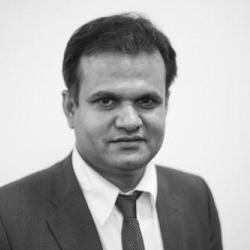Biography
Dr Siddharth S Saxena is a Principal Research Associate Academic at Cavendish Laboratory, University of Cambridge and a Fellow Commoner at Jesus College. He has been an EPSRC Advanced Research Fellow, Sarah Woodhead Fellow, Girton College, Cambridge, a Postdoctoral Fellow at University College, London and a Spinoza Fellow at the University of Groningen, the Netherlands, after completing a PhD at Trinity College, Cambridge in 1998. He is also director of the Cambridge Central Asia Forum.
Recently, he has been chair, organiser, advisory committee member and session-chair of a number of international conferences such as the Gordon Conference, SCES series, AIRAPT, M2S, MSM and Quantum Complexities in Condensed Matter as well as Quantum Condensates Conference. He has delivered plenary, key-note and invited talks at more than 70 international conferences during the last six years.
He also held directorships of Centre for Materials and Microsystems, FBK, Trento Italy and Centre for High Technologies, Tashkent Uzbekistan previously. He also teaches at Centre for Development Studies, University of Cambridge.
He was awarded the International Union of Pure and Applied Physics (IUPAP) Young Scientist Medal in 2006 and a Medal for Service to Education by the Kazakh minister of education and a honorary doctorate and two honorary professorships in 2009 and 2012. Presidential Medals of Honour from both Uzbekistan and Kazakhstan in 2011, were also conferred.
Research
Dr Saxena's research programme focuses on novel forms of quantum order in metallic and insulating magnets, intercalated compounds, ferroelectric systems and multi-ferroic materials. In particular he has pioneered the study of model materials in which the magnetic and charge ordered states give way to exotic superconductivity and other forms of novel quantum order as a function of applied hydrostatic pressure.
With his co-workers, he discovered the coexistence of a novel form of superconductivity and itinerant-electron ferromagnetism in the f-electron metal UGe2 (Nature 2000), the first example of its kind. Importantly the magnetic electrons in this material can be described in terms of a spin polarized Fermi surface and thus the magnetic electrons participate in the formation of a spin-triplet superconducting state.
He and collaborators from UCL led a team to the discovery published as cover story in Nature Physics of an unexpectedly robust form of superconductivity in the intercalated graphite compounds C6Yb and C6Ca. This discovery motivated numerous theoretical and experimental studies worldwide and has led to a revival of the field of carbon-based superconductivity and a re-examination of electron pairing mechanisms in general.
Over the last decade he has led an investigation of the insulator to metal transition in the van der Waal compounds of the type MPS3 where M stands for a transition metal element. These are low-dimensional systems that are magnetic insulators at ambient pressure but are expected to display an unconventional form of superconductivity at very high pressures. He has paved the way to the search for this type of superconductivity via a series of lattice and electronic structure studies up to several hundred thousand atmospheres. These studies that are of wide interest in their own right in a rapidly developing field of magnetic van der Waal materials (magnetic graphene) have just been published in Physical Review Letters (2018)
His group has also pioneered in particular the study of quantum critical phenomena in displacive ferroelectric materials and of superconductivity on the border of ferroelectric quantum phase transitions. With his students he has carried out a series of high-precision studies as a function of electric field, temperature and pressure that have dramatically confirmed for the first time the applicability of the Larkin-Khmelnitskii-Schneerson theory of the quantum critical state in displacive ferroelectrics and of the Gurevich-Larkin-Firsov-Takada theory of superconductivity in polar materials. This work, published in Nature Physics (2014) & PNAS(2020), constitutes a major advance in the description of the quantum properties of ferroelectrics and opens up new opportunities for the study of exotic normal and superconducting states in polar materials including order-disorder as well as displacive ferroelectrics, ferrielectrics, anti-ferroelectrics and multi-ferroics.
Publications
Key publications:
Recent advances:
a) Emergent Magnetic Phases in Pressure-Tuned van der Waals Antiferromagnet FePS3 Phys Rev X (PRX) https://journals.aps.org/prx/abstract/10.1103/PhysRevX.11.011024 5th of February 2021
b) Superconductivity mediated by polar modes in ferroelectric metals Nature Communications, journal-article https://doi.org/10.1038/s41467-020-18438-0 25th of September 2020
c) Quantum Critical Phenomena in Compressible Displacive Ferroelectric Proceedings of the National Academy of Sciences (PNAS) journal-article DOI: 10.1073/pnas.1922151117 26th of May 2020
d) Isostructural Mott transition in 2D honeycomb antiferromagnet V0.9PS3 NPJ QUANTUM MATERIALS DOI: 10.1038/s41535-019-0178-8 Volume: 4, Article Number: 38 Published JUL 25 2019
e) Pressure-Induced Electronic and Structural Phase Evolution in the van der Waals Compound FePS3 PHYSICAL REVIEW LETTERS DOI: 10.1103/PhysRevLett.121.266801 Volume: 121 Issue: 26, Published: DEC 28 2018
Highlighted Key Publications:
1. Superconductivity on the border of itinerant-electron ferromagnetism in UGe2
NATURE Volume: 406 Issue: 6796 Pages: 587-592 Published: AUG 10 2000
https://doi.org/10.1038/35020500
2. Superconductivity in the intercalated graphite compounds C6Yb and C6Ca
NATURE PHYSICS Volume: 1 Issue: 1 Pages: 39-41 Published: OCT 2005
https://doi.org/10.1038/nphys0010
3. Spin-polarized transport across sharp antiferromagnetic boundaries
PHYSICAL REVIEW LETTERS Volume: 88 Issue: 24 Article Number: 247204 Published: JUN 17 2002
https://doi.org/10.1103/PhysRevLett.88.247204
4. Ferroelectric quantum criticality
NATURE PHYSICS Volume: 10 Issue: 5 Pages: 367-372 Published: MAY 2014
https://doi.org/10.1038/nphys2924
5. Pressure-induced insulating state in (La,Sr)CoO3
PHYSICAL REVIEW B Volume: 69 Issue: 14 Article Number: 140403 Published: APR 2004
https://doi.org/10.1103/PhysRevB.69.140403
6. 4-spin plaquette singlet state in the Shastry-Sutherland compound SrCu2(BO3)2
NATURE PHYSICS Volume: 13, Issue: 10 Pages: 962-+ Published: OCT 2017
https://doi.org/10.1038/nphys4190
7. Dielectric Response of Quantum Critical Ferroelectric as a Function of Pressure
SCIENTIFIC REPORTS Volume: 8, Article Number: 14936 Published: OCT 8 2018
8. Observation of the transverse optical plasmon in SmLa0.8Sr0.2CuO4-delta
PHYSICAL REVIEW LETTERS Volume: 86, Issue: 18 Pages: 4144-4147 Published: APR 30 2001
9. Bulk evidence for single-gap s-wave superconductivity in the intercalated graphite superconductor C6Yb PHYSICAL REVIEW LETTERS Volume: 98, Issue: 6 Article Number: 067003 Published: FEB 9 2007

